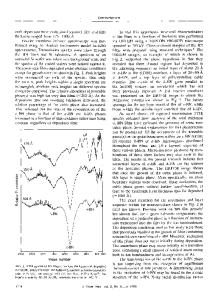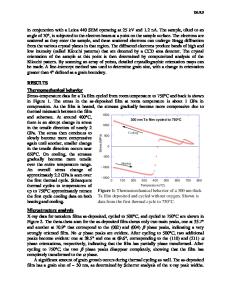Surface Evolution of NiTi and NiTiHf Thin Films
- PDF / 463,840 Bytes
- 6 Pages / 612 x 792 pts (letter) Page_size
- 64 Downloads / 337 Views
Surface Evolution of NiTi and NiTiHf Thin Films Chen Zhang*, Ralph H. Zee* and Paul E. Thoma** *Materials Research and Education Center, Auburn University, Auburn, AL 36849; **Corporate Technology, Johnson Controls, Inc., 1701 West Civic Dr., Milwaukee, WI 53209 ABSTRACT The microstructure evolution of Ti-rich NiTi thin films and (TiHf)-rich NiTiHf thin films containing 9at% Hf was investigated. These films were deposited from single NiTi and NiTiHf targets using a DC magnetron sputtering system. Free-standing films were obtained by using single crystal silicon substrates. The thickness of these films was controlled between 10-12 µm. In this investigation, the effects of deposition temperature on the surface and cross-sectional microstructures of these films were studied. Substrate temperature during deposition was varied between 300°C to 700°C at 100°C intervals. The influence of post deposition heat treatment (HT) temperature on the microstructure of these films was also studied. The post deposition HT temperature was varied between 300°C and 800°C at 100°C intervals. Both surface and crosssectional microstructures were examined using a scanning electron microscope (SEM). The crystallinity and the phases present were determined using x-ray diffractometry. All the asdeposited films were found to be crystalline, even when the substrate temperature was as low as 300°C. Results from the microstructure analysis show that all the films have a relatively fine grain size ranging from 0.2 µm to 2.5 µm, and the grain size increases with increasing substrate deposition temperature. The effect of post deposition HT on grain size was found to be minimal. INTRODUCTION Many investigations have been devoted to better understand the behavior of bulk shape memory alloys (SMAs) since their discovery in the 1960s. The achievements in development of SMAs have been significant. As a result, their commercial value has increased rapidly in the past few years. Many applications have been developed including actuators, electronic connectors, and medical implants such as stents and guidewires. Recently their applications have been extended to microactuators due to the increasing demands for miniature devices. Since shape memory alloys are used as an actuator element, by making it into a thin film, a new type of microactuator with high output stress and output strain becomes possible. Meanwhile, a drawback of bulk SMAs, such as slow response, can be overcome by increasing the actuator element’s surface to volume ratio. NiTi thin films have been successfully fabricated and studied in the past ten years. Ternary NiTiHf SMA with high Hf concentration becomes more and more attractive due to its high transformation temperatures. The possibility of fabricating NiTiHf thin films, containing 10at% Hf, was first reported by Johnson et al. [1]. However, a reliable method for manufacturing micron-thick shape memory thin films, especially for high temperature shape memory thin films, is still not available. Further studies are needed to better understan
Data Loading...











